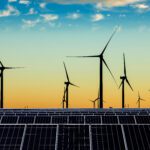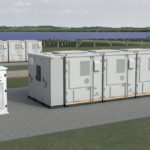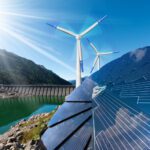LFP Battery Technology Chosen for Australia Project. Maoneng, an Australian renewable energy company, in August said its proposed battery energy storage system (BESS) in Victoria state’s Mornington Peninsula will use lithium iron phosphate (LFP) batteries. Maoneng cited LFP’s safety record as a key factor in the group’s choice. LFP technology is used worldwide in several applications, and Maoneng representatives said the decision to adopt it came after “an extensive technical analysis of various battery types available on the global market.” LFP batteries have higher thermal stability, and less dense chemical composition, than other technologies widely used in utility-scale batteries. Maoneng said the Mornington BESS, a 240-MW/480-MWh project scheduled for completion in 2022, will have other safety management measures incorporated into its design, including what it called a state-of-the-art fire detection system, along with an advanced, always-on fire suppression system used in a variety of power generation, and oil and gas projects. The group said the BESS also can deploy a condensed aerosol agent to quickly and automatically handle any potential hazard. Maoneng said the agent is environmentally friendly, and typically remains suspended in the battery container to help prevent reignition. The Mornington BESS Project is located adjacent to AusNet Services’ Tyabb Substation, where the BESS will connect to Australia’s National Electricity Market.
UN Approves Solar-to-Hydrogen Microgrid Design. Angstrom Advanced, an energy company and parent of Verde LLC, in August said the United Nations Development Program (UNDP) successfully completed the acceptance test of Angstrom’s solar-to-hydrogen microgrid project design. Angstrom, based in Massachusetts and a global hydrogen electrolyzer supplier, said the project is designed to establish “a hydrogen-based renewable energy storage system to break through the bottleneck associated with the utilization of unstable renewable energy (such as solar and wind power).” Angstrom said it foresees its commercialized megawatt-scale containerized water-electrolysis hydrogen generators, with skid-mounted hydrogen refueling stations, and the company’s own “big data platform,” will make it “feasible for establishing and implementing hydrogen energy communities or hydrogen cities.” The company said hydrogen “would be the critical medium in bringing together renewable energy, power, heat and utilities, and the ability for grid peak-shift.” Angstrom said its hydrogen also could be used as a backup power source, as well as fuel for vehicles powered by hydrogen fuel cells. The company said the ultimate goal of the “Hydrogen Energy Communities” program is to take advantage of hydrogen as a “clean, zero-emission energy source to achieve sustainable development, as well as carbon neutrality.” Angstrom to date has designed and built solar/wind hydrogen-based energy storage microgrid projects in Jiangsu, China, along with a development in Massachusetts.
Deal Reached for Solar Projects in Asia. AC Energy Corp., based in the Philippines, in August announced a joint venture with Hong Kong-based solar developer NEFIN to develop, build, and operate rooftop solar installations across Asia. AC Energy will manage its efforts in the joint venture (JV) through its AC Renewables International (ACRI) subsidiary. The companies said the joint venture will own 21 MW of generation capacity across several countries, including Malaysia, China, and Taiwan, as well as in Hong Kong. NEFIN is a longtime rooftop solar engineering and management company, with more than 300 MW of commercial and industrial, along with utility-scale, solar systems in place. AC Energy in announcing the deal said it oversees more than 1 GW of generation capacity—about half of that renewables—in the Philippines. The company has a goal of having 5 GW of renewable generation capacity in its portfolio by 2025. ACRI said it has an international investment of $10 million in the JV with NEFIN. The companies have said the JV’s investments will focus on “socially responsible and commercially viable” projects.
AGL Will Use Wärtsilä BESS in Australia. Technology group Wärtsilä will supply a BESS to AGL Energy Limited for a 250-MW/250-MWh system at Torrens Island in South Australia. The installation is AGL’s first grid-scale BESS project, and the second biggest in Australia. The system is designed to support a broad portfolio of generating assets, both thermal and renewable. AGL is an integrated essential service provider with electricity generation capacity of more than 11 GW, representing about 20% of the total generating capacity within Australia’s National Electricity Market (NEM). The order, an investment of more than €100 million ($117.6 million), is the first placed under a framework agreement signed between Wärtsilä and AGL in 2020 for the supply of energy storage projects. AGL plans up to 1 GW of grid-scale energy storage across Australia. The Torrens Island system will be delivered by Wärtsilä on a full engineering, procurement, and construction (EPC) basis, and designed to provide grid-support capabilities to AGL’s asset portfolio. It is expected to become operational in the early part of 2023. The Wärtsilä system will operate initially in grid-following mode before switching at a later date to grid-forming mode (virtual synchronous generation, or VSG). The system is supported by Wärtsilä’s advanced GEMS Power Plant Controller and energy management software.
Saudis Bring First Wind Farm Online. Saudi Arabia officials in early August said the country’s first wind farm was connected to the power grid. The Dumat al-Jandal installation, a 400-MW project that includes 99 wind turbines, is a development led by renewable energy companies EDF Renewables and Masdar. The project is supported by the Saudi Arabia Ministry of Energy, Saudi Power Procurement Co., and the Saudi Electricity Co. It is part of Saudi Arabia’s Vision 2030, a project intended to diversify the kingdom’s economy and move Saudi Arabia away from its dependency on oil. Construction of the wind farm began in September 2019.
Bruc Energy Buying Solar Projects. Opdenergy, a renewable energy company based in Spain, in August announced it has sold a portfolio of 20 solar projects to Bruc Energy, an investment firm owned by British and Canadian pension funds, and Spanish businessman Juan Bejar. Terms of the deal were not disclosed. Opdenergy said it would use the money from the sale to develop other projects in Spain and in the U.S. The group said it expects to have an additional 585 MW of power generation capacity in its project portfolio by year-end. Bruc Energy, owned by the UK Universities Superannuation Scheme, the Ontario Pension Trust, and Bejar, has been making numerous investments in Spain, a country looking to increase its solar power generation capacity. Bruc earlier this year purchased renewable energy assets totaling 2 GW of generation capacity.
—Darrell Proctor is a senior associate editor for POWER.










